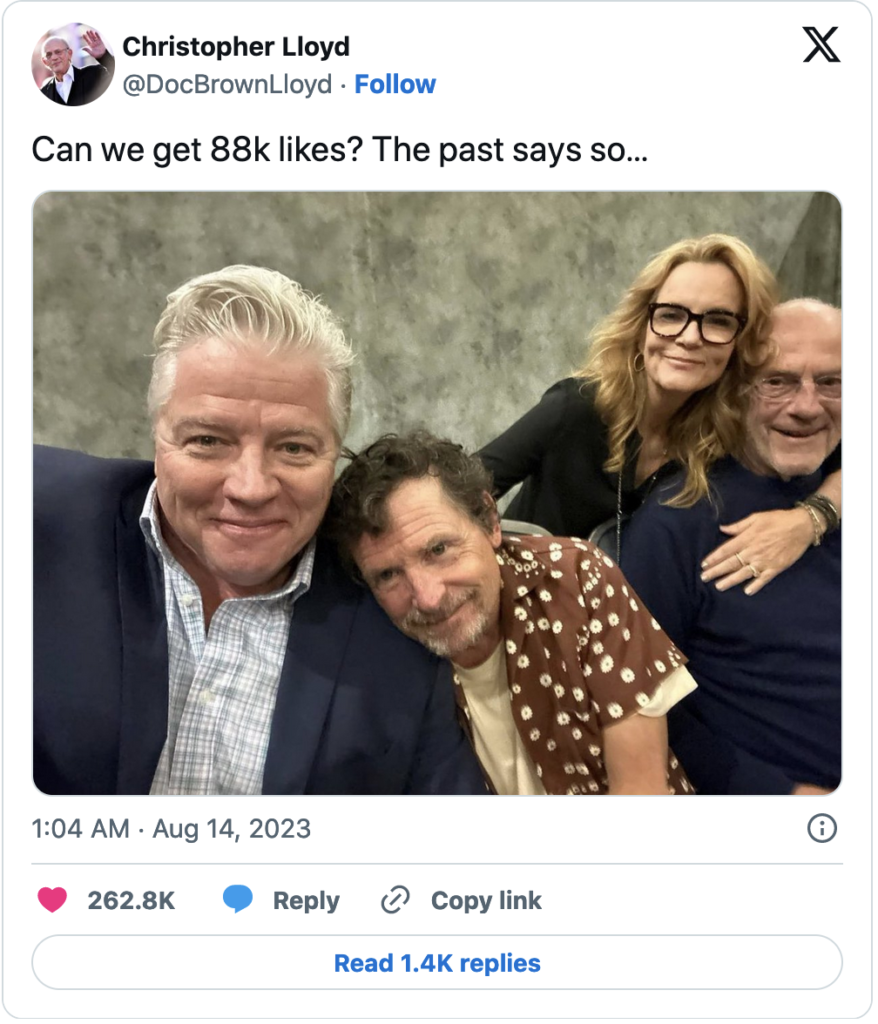Is this the first time Scriptshadow gets sexy in a script review??
Genre: Thriller
Premise: (from Black List) A successful author/wife/mother plans a trip to a bucolic island to crack her next book and finds herself in a surprising situation.
About: Today we get the rare CELEBRITY script, as Power Rangers’ very own Amy Jo Johnson wrote today’s screenplay, which made last year’s Black List. More actors should be writing their own material and creating their own way like Amy Jo Johnson. The woman is a straight-up inspiration. Now someone please tell me what “bucolic” means.
Writer: Amy Jo Johnson
Details: 114 pages
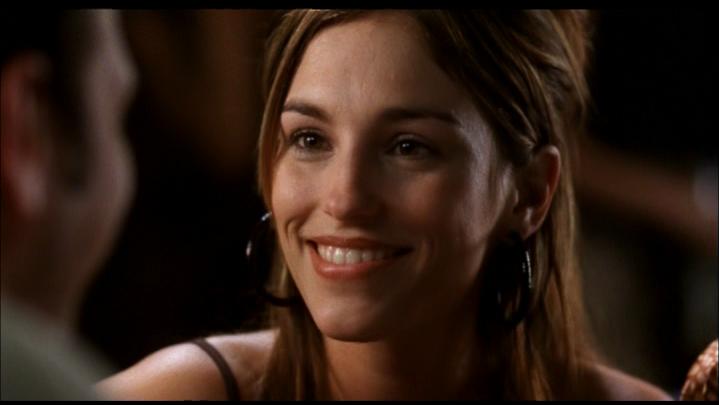
Today is a first on Scriptshadow.
I am about to do something that I’ve never before been faced with on the site.
I am going to read a script from one of my early crushes.
We’re talking Mighty Morphin Power Rangers. Felicity. And the utterly underrated, “Hard Ground.”
Amy Jo Johnson everyone. If you don’t know who that is you need to be arrested for dumbness.
Look, it’s not going to be easy reviewing today’s script. How can I ever judge AJJ objectively? What am I going to do if the script is an Amy Jo Disaster? Even if AJ has never heard of the site, I’ve learned that most of the writers of these scripts are made aware of the review at some point or another. Does that mean any potential future between Amy and I is 69’d? Wait, not “69’d.” That’s the wrong term. What’s the right word? 86’d! That’s what I meant to say. “86’d.” Honest slip of the keyboard. Sorry about that, guys.
Let’s get to the script!
Jennifer is a 45-year-old novelist with a family and a husband, Steven, who’s her biggest fan. Well, he *was* her biggest fan. He’s the agent who signed her and began her successful run on the best-seller list. But Jennifer hasn’t written a book in 5 years. She’s got an ugly case of writer’s block.
So Steven decides to rent Jennifer a house in the middle of nowhere (Alderney Channel Island) for three weeks so she can finally finish her latest book, “What We Became.” Jennifer doesn’t want to do it but the reality is, they’re running out of money. If they don’t start selling books again, they’re going to be looking for studio apartments on the south side of the 10 freeway.
Once on the island, Jennifer meets a young beautiful woman named Kathleen. Kathleen informs her that the house Jennifer is staying at was used by the Nazis for secret meetings back in World War 2. Kathleen offers to bring groceries over, periodically. But not any normal groceries. SEX GROCERIES (‘sex groceries’ is a term I just made up. It means getting people groceries when what you *really* want to do is have sex with them).
Jennifer is both elated and mortified by her desire for Kathleen. But what is she gonna do when the hot little number keeps swimming naked in her pool? I mean, who can resist that? Not Jennifer.
Not long after they start sleeping together, Jennifer heads into town and meets Kathleen’s mother by chance, who tells her Kathleen is dead and has been for five years. Wrestling with her newfound potential necrophiliac status, Jennifer confronts Kathleen, who admits that she’s not Kathleen. She’s actually a fan.
Jennifer is so turned on by this chick that she keeps sleeping with her anyway, despite the creepy fan stalker issue. It helps that she’s flying through the pages of her novel. She’s never been this inspired in her life. She’s so inspired that she straight-up ignores her husband’s calls, to the point where Steven gets worried and flies to the manor, where he learns that his wife has been sleeping with the help.
After a big blow-up between Jennifer and Steven, Jennifer has to figure out, once and for all, who her lover is. Is she a liar, a ghost, a Nazi, a stalker? One thing’s for sure, whoever Kathleen is, she’s unstable. And that lack of stability is going to lead to a giant confrontation.
I have good news, everyone.
I liked it!
You all know this about me. Put a character on an island and I’m in.
Make them a writer and I’m even more in. Of course I’m going to be pulled in by a story set in the subject matter of my chosen profession.
The only thing holding this script back is the fact that, with the wrong director, it becomes a cheesy Netflix romantic thriller. But with a good director, it could be awesome.
Cause Johnson writes in a sophisticated enough way that the story is elevated above your run-of-the-mill romantic thriller. She’s very detailed when she writes. She’s good at describing the setting – adding just enough detail to convince us that we’re really there.
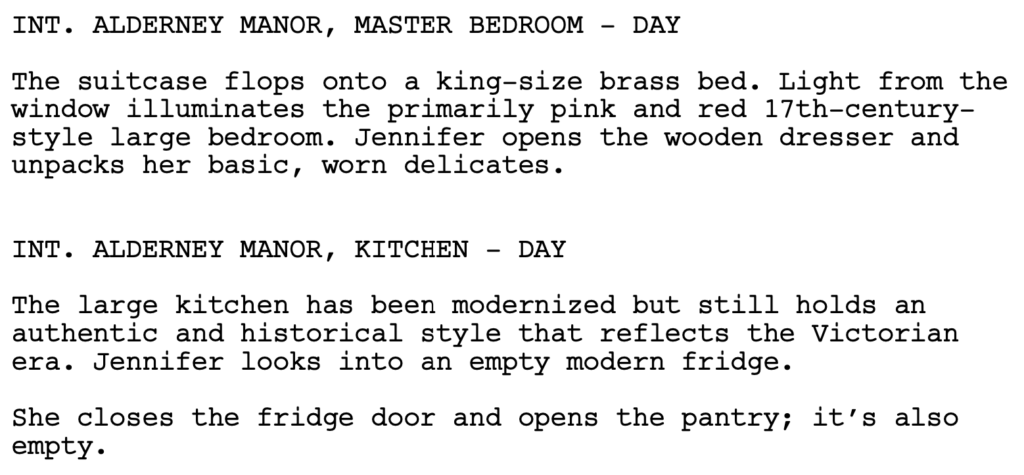
In scripts like this, it’s the sum of all the mini-parts that elevate the script above average-ness. For example, this could’ve taken place anywhere. In some generic woods setting, for example. Placing it on the Alderney Channel Island, an island I’ve never heard of, off the coast of Britain, made it feel real. Specifics and detail help your story every time. Never forget that.
I say that as someone who just read two scripts from writers who used little-to-no-detail. Who always went with the basic general option. It’s the difference between having your characters get the pear-gorgonzola gelato at Gelateria Fatamorgana and… your character go to the “ice cream shop” to get “yummy ice cream.” Specificity makes a difference.
Another thing that impressed me here was the sex stuff. We don’t usually talk about sex on the site. Sex scenes are tricky, to shoot as well as to write. Because if you’re too soft, they’re boring. If they’re too hard, they become exploitative and overwhelm the moment, pulling the reader out of the story.
I thought Johnson wrote these perfectly. The scenes are sexy, slightly original, occasionally push the boundaries, and most importantly, remain authentic.
I think the reason sex scenes can be challenging is because, in order to make them authentic, we do have to bare our soul a bit. We have to give those uncomfortable details of our own sexual experiences because those are details that make the moment feel real. If you try and write, “He gets on top of her. They kiss. She moans.” That’s not going to cut it. It’s too generic to make an impact, especially in a script like this where the sex is a key component to the plot.
If I have any complaints about the script, I’d say Johnson relied too much on twists and turns. I loved the first twist of Kathleen being dead. I thought, “Ooh, are we going into ghost territory here?” Then there’s another twist where we learn she was just saying she was the dead girl to hide her own identity and that she’s actually a fan. Then there’s another twist still that she’s never read one of Jennifer’s books. And there’s even another twist after that.
Twists are fun. But most scripts can’t handle more than two big twists. Cause if every ten pages is a twist, then we stop believing in what’s happening and we don’t trust the writer anymore. Just to be clear, smaller twists are fine. But big twists? 1 or 2 is all you need.
Let’s be honest. The “romantic thriller” isn’t the coolest genre on the block. A lot of industry people roll their eyes at it. But if you’re passionate about a genre, even if it isn’t cool, you should write in that genre. Cause that’s the genre you’re going to be the most passionate writing. That passion is likely to result in a good script, like this one.
[ ] What the hell did I just read?
[ ] wasn’t for me
[x] worth the read
[ ] impressive
[ ] genius
What I learned: Don’t introduce juicy red herrings that you’re not going to pay off. That’s like promising steak for dinner and cooking SPAM. Red herrings are a great way to get the reader off your scent. I encourage using them in any mystery. But don’t introduce a big fat juicy red herring – like Nazis – and not pay it off. Cause it’s just going to upset the reader. I was hoping that the Nazis came back into this script somehow after they were mentioned in the first act. So I was bummed when that setup was abandoned.
August Logline Showdown deadline is THIS THURSDAY! Details below on how to enter!
Genre: 1 Hour Drama Pilot
Logline: In a small town located within the ‘Quiet Zone’ – an area of the country where cell service, WiFi and other transmissions are banned due to a secretive government research facility – an ambitious journalist investigates a string of missing persons cases and finds herself unraveling a larger conspiracy as she begins to expose the dark secrets within the zone.
About: Today we’re looking at the third-place finisher for Pilot Logline Showdown.
Writer: Sam Van Meter
Details: 55 pages
 Portman for Amy?
Portman for Amy?
I’m also using today’s review to remind you that we have the August Logline Showdown happening this Friday. Deadline is Thursday night. For Logline Showdowns, you send me a logline for a script. I then pick the best five loglines and they compete on the site with you guys voting. Whoever wins gets a script review the following week.
What: August Logline Showdown
Enter: Feature Screenplay Loglines Only
Deadline: Thursday, August 24th, 10:00 PM Pacific Time
Where: carsonreeves3@gmail.com
Okay, onto today’s review.
Some of you noted that “Quiet Zone” was the most “TV” pitch of the TV Logline Showdown. I agree. I liked the high concept aspect of the pitch. Now it’s time to see if the writer delivered.
Our story starts out in a forest, where we see the body of a young dead woman. We then meet 12 year olds Nick and Charles, who are playing around in that same forest. They hear some scary noises and see a dark shadow so they run as fast as they can. Nick makes it but it doesn’t look like Charles does.
Cut to our heroine, Amy, in her Chicago apartment. After orgasming, she tells her hookup buddy that she’s uninterested in returning the favor. She tells him that she’ll be gone for a while. She’s going to go check out this town called Blue Bank in West Virginia. She wants to write a story on a nearby research facility and, also, the fact that there’s no internet in the area.
Cut to Claire and Dave, a young married couple who are trying to escape to Blue Bank because Claire keeps getting headaches due to all the wireless and electro waves in the air. Apparently, some people head to Blue Bank to escape this, since Blue Bank doesn’t have any of these things.
We then meet the local sheriff of Blue Bank, Kevin. Kevin visits Suzy Walters to see how she’s doing. Suzy’s daughter has been missing for a while now and she’s falling apart. Suzy isn’t the only one dealing with this issue. There are several other people who have gone missing in town.
Amy finally arrives in town and meets Claire and Dave. She expresses interest in this mysterious research facility and starts driving around town. She eventually runs into Nick, from the opening scene, as he’s running out of the forest. Cut to black. End of episode 1.
When it comes to TV, more so than film, the dialogue has to be good. Remember that movies are more plot-driven. Because they’re plot-driven, a lot of the dialogue will deal with exposition. The characters will have to keep updating the audience on what they’re trying to do and what comes next.
TV is less plot-driven. Even the most plot-driven shows are less involved with plot than a movie. Instead, TV is about character. And because it’s about character, most scenes will highlight the characters conversing with each other.
This is why dialogue is so important in TV. It’s more of an expression of the characters as opposed to a vehicle to convey plot.
Quiet Zone had a lot of dialogue that didn’t meet the standard required for a show that gets on the air. It started with the two boys playing in the forest. These boys are 12 years old. Yet they spoke like they were 15 year old girls. Here’s a brief excerpt from their exchange.
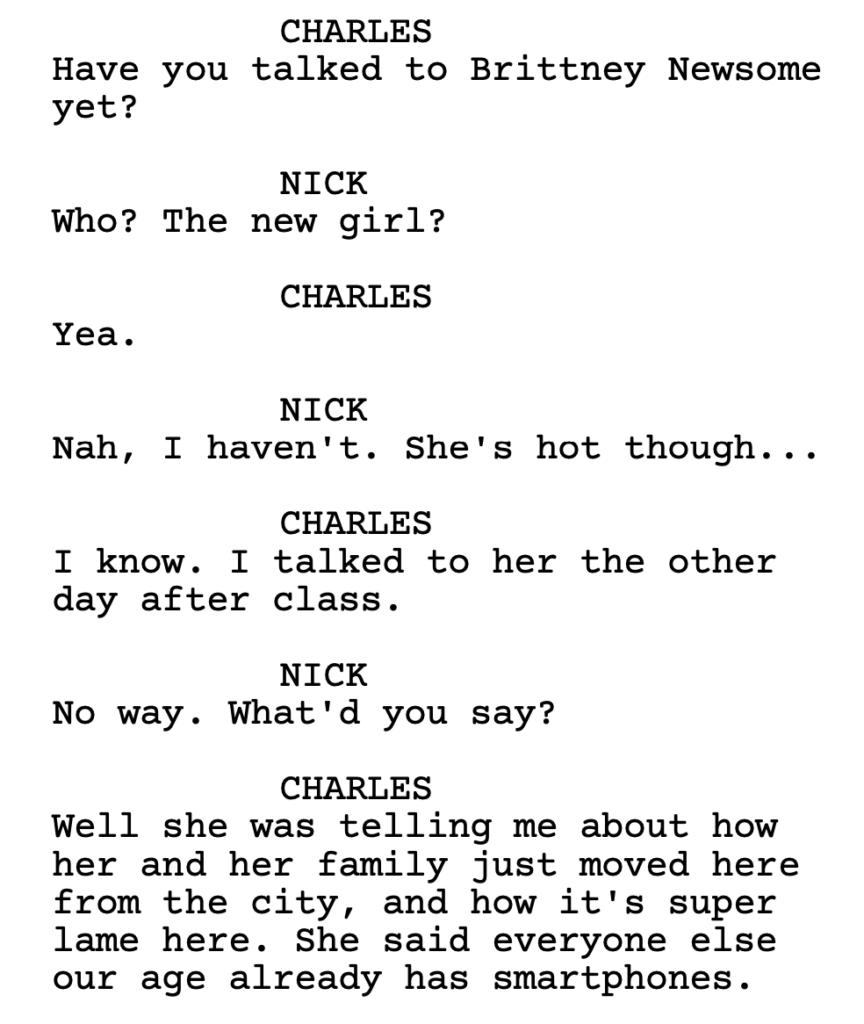
So, already, my confidence is dipping.
Not long after that, we get this conversation between a married couple, Dave and Claire, where the dialogue wasn’t doing anything other than existing. There was no life to it. And if there’s no life to your dialogue, there’s no life to the characters speaking that dialogue. Because dialogue is the extension of each person’s personality.
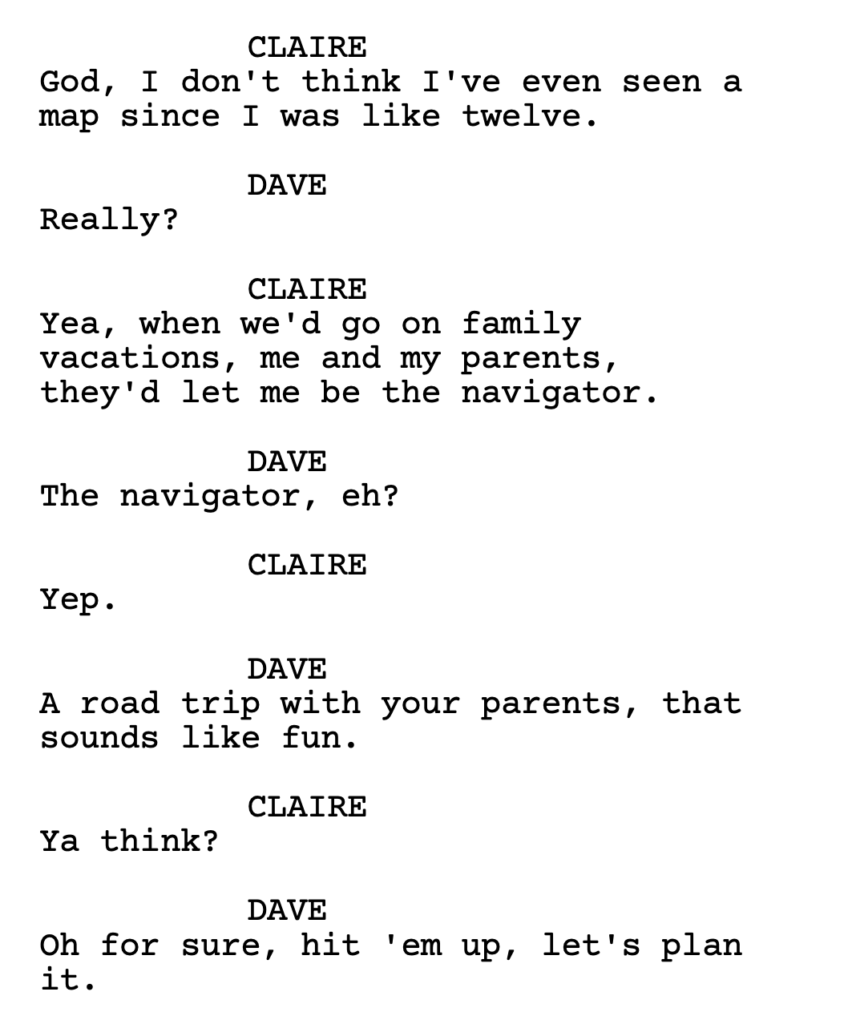
After I finished reading “Quiet Zone,” I sat with my thoughts for a good 30 minutes, trying to figure out why the pilot didn’t resonate with me. I knew that something wasn’t working but I wasn’t sure what it was. So I did a quick second read-through and that’s when the problem hit me: everything about the story was too casual.
It started with Amy. I’m assuming Amy is our main character but it’s hard to tell. In any movie or show, you want there to be a major force pushing your characters forward.
Yet here we have Amy, a journalist, who just seems to have nothing better to do than head to Blue Bank, Virginia. Here she is telling her sorta-boyfriend where she’s going. “Just doin’ some research on the next piece I’m writing.” “What is it?” “It’s on this town in West Virginia. Blue Bank, West Virginia.” “Oh. What’s exciting about a small town in West Virginia?” “It’s just a potential story I’m working on. I’m gonna head down there soon.”
Does that sound like a major force pushing a character forward? Amy seems almost bored by the idea of going to this place. If she’s bored, how do you think we feel?
And it isn’t like you don’t have ways to create that force here. There’s this mysterious research facility. There are multiple missing people in Blue Bank. I would’ve loved a scene with her at the Tribune pitching this story to her reluctant boss. “There’s this really sketchy research facility I’ve been doing research on for the past three months. People keep going missing there. I think there’s a connection.” Let’s see some fire! Let’s see a REASON why she goes to this place other than mild curiosity, which is how it’s presented now.
As an extension of that, every other storyline is too casual. You have a unique premise here. You have this town that isn’t connected to the internet. It’s a dead spot. It’s like living in 1985. But there’s none of that on the page. In fact, if I hadn’t read the logline before reading the pilot, I wouldn’t have known about the concept! That’s how casually it’s dealt with. Outside of one person saying they’ve come here because they get headaches, this could’ve been any town in America.
Why aren’t we exploring the promise of that premise more? Why aren’t we focusing more on what’s DIFFERENT about this universe than what’s the same? It would be like writing a Jurassic Park pilot and there be one brief mention of a small dinosaur out by the beach.
Particularly, your featured scenes need to highlight what’s unique about your concept. The opening scene has two kids running from someone in a forest. That could literally happen in any script. Why aren’t we looking to find scenes that could only happen in *this* script?
Overall, the pilot seemed like it was written too fast. Like Sam didn’t sit down and figure out what’s unique about his world. Figure out ways to create depth and originality within this universe. There’s even a flashback scene with Amy when she was a kid. In it, she’s in a car with her parents at night and the car crashes, presumably killing both parents.
If I see a car crash backstory, that’s it for me. From that point on, I’ve given up on the script. Why? Because I read a million car crash backstories. It’s lazy. And when you’re doing the thing that everybody else does, it tells me you’re not trying to be unique. You’re not attempting to differentiate your script.
This script needed to be obsessive with its concept. As it stands, it’s only mildly curious about it. That mild curiosity bleeds into our reaction. Since the writer is only mildly curious, we’re only mildly curious. For scripts to resonate, the reader needs to be obsessed with what’s going on.
[ ] What the hell did I just read?
[x] wasn’t for me
[ ] worth the read
[ ] impressive
[ ] genius
What I learned: If characters only seem mildly invested in what’s going on, the reader is only going to be mildly invested in what’s going on.
Is today’s script the best horror entry of the entire 2022 Black List??
Genre: Horror
Premise: To save her friend, a maid in a decaying manor must unravel the secrets of its inhabitants while confronting spirits, her own terrifying abilities, and the very real horrors of Depression-era America lurking outside the door.
About: Another writer brand new to the scene here. But that doesn’t mean he hasn’t been putting the work in. Evan Enderle has been writing screenplays for at least six years as he was the recipient of the 2017 Rough Draft Residency with The Drama League in New York. Put in those reps, everybody! Assuming he wrote between 1-2 scripts a year since then, he could have as many as ten screenplays under his belt. In my experience, somewhere between 6 and 10 scripts is when a writer finds their screenwriting legs. We’re going to talk about how many scripts screenwriters should be writing in the next newsletter as I’ve come across lots of writers who are approaching it the wrong way. If you want in on my newsletter, send me an e-mail at carsonreeves1@gmail.com.
Writer: Evan Enderle
Details: 112 pages

A hurricane?
In LA?
Is that even possible?
This past week I was hanging out with extended family on vacay. For perspective, my family was seeded, and then sprouted, from the endless fields of Indiana. They are proudly mid-western and, because of this, I wanted to know what kind of content they were into. What movies does the “Average Joe and Joan” in middle America up and leave their houses to see? What shows did they drape themselves in potato chip crumbs to binge?
I got only two universal answers.
They all loved Barbie.
And they all loved White Lotus.
Well, at least they half have good taste.
As much as I’d like to take you down another backroad of Barbie Land and trade definitions of the patriarchy, we’ve got a new script to review! I know Poe’s been hyping this one up. Let’s see if he was right.
20-something Lucy Moore arrives at Ravenswood Manor in 1931, on the outskirts of Tarrytown, USA. Lucy has been brought here as a maid to serve under the evil Ms. Crowne, the real-world equivalent of the wicked witch of the west. Crowne isn’t happy just making her workers depressed. She wants to make them les miserable.
After a tough first day, Lucy buddies up with another maid, Gertrude. The two are fast friends, which Crowne immediately picks up on. A day later and Gertrude has mystreruousy disappeared. Crowne says she left voluntarily during the night. But Lucy’s not buying it.
Before she “left,” Gertrude told Lucy about a special room in the manor. And after meeting Hale, the studly son of the woman Lucy looks after, Mrs. Dyer, the three are summoned to the special room, which we learn is a “ghost room” of sorts, where spirits are summoned. Right away Lucy is uncomfortable. She seems to have a special connection with the dead, a power passed onto her by her grandmother.
After connecting Mrs. Dyer with her dead husband, Lucy becomes a favorite of the woman, who insists to a furious Crowne that Lucy stay with her 24/7. Crowne attempts to undermine Lucy when she realizes her power is growing within the manor, but to no avail. The client, Dyer, likes Lucy too much.
With her newfound access, Lucy looks deeper into Gertrude’s disappearance only to discover a chilling truth – that Gertrude may not be dead or alive, but rather, stuck in limbo. Lucy will have to find her friend and set her free. But this will mean infiltrating Ravenswood’s most hideous secret – a secret that will change the nature of life as we know it.
This is DEFINITELY one of the better written scripts on the Black List. The writing is simple, descriptive, and, most importantly for a horror script, haunting. It feels professional right from the bump.
She waits, dwarfed by the soaring ceilings reflected in the shining marble floors. She takes a few tentative steps, surveys the sweeping grand staircase.
All is silent except for the soft POP of logs burning in the impressive fireplace. A YELLOW CAT watches from the shadows.
There’s also a sophistication to the dialogue that you don’t often see in the post 2018 Black List Era – in other words, dialogue that’s actually good.
“You are a queer one, Lucy. The girl who would refuse a job when so many are suffering. And now to be caught thieving and in hysterics in the middle of the night. The entitlement of it.”
Note the reversed nature of that final statement. Normally, that would go near the front of the sentence. “Do you understand how entitled you sound, Lucy? You’ve refused a job when so many are suffering.” But in real life, we don’t always think linearly. We come up with our thoughts on the fly, occasionally backloading sentences with points we realized we left out earlier. To write dialogue that reflects that is high level stuff.
Where this script is going to live or die, however, is with each individual’s preference regarding how they like their horror. If you like to have fun with your horror (Paranormal Activity), this script isn’t for you. If you like a giant infusion of drama in your horror (Let The Right One In), this is the script you’re going to be telling your horror buddies about.
Ravenswood puts on its “serious hat” from the outset. This script is about mood. It is about feel. Heck, you can practically smell the mildew within the manor, the novel-esque description is so thick.
It is both the script’s main strength and weakness. I dug it. I felt much more fear when we were placed in dangerous scary situations here (inside a garden maze with a headless gardener) due to how seriously the writer was covering the events. But it *did* come at the expense of being 40 pages into the script and still not knowing what the point of the story was.
This happens when you don’t add a clear goal. Which is fine. Horror movies are often powered by a looming sense of dread, of knowing that the monsters are coming. Being stuck in an ancient giant shadow-filled haunted house promises us many a spooky endeavor. But you can only milk that udder for so long before the reader starts demanding purpose.
Eventually, Enderle seemed to realize that Gertrude was the key to crafting any sort of narrative and therefore embraced the mystery of her having gone missing. This gave the script its coveted goal. But even then, the goal seemed to be stirred into other, less sexy, plotlines, such as the nonexistent romance plot between Lucy and Hale. That had real potential but the writer seemed to grow bored of it in real-time, as it had all but vanished (like a ghost) by the arrival of the first act.
The good news is, there were more good plotlines than bad ones. I was obsessed with the way Crowne pushed Lucy around, to the point where I would’ve been happy reading the entire script just to see Lucy stick it to her in the end, even if there hadn’t been any horror.
Speaking of, the horror imagery was good. Headless dogs. Headless gardeners. Limbless other animals and humans – all stuff Lucy kept seeing. It made for a nice mystery. We knew someone was lopping off body parts machete-style. But who was it? And why were they doing such a thing?
But the star of this script was always the writing. Even if I would’ve preferred more dialogue to make the read easier, I noticed a higher level of writing across the board, and it really made a difference in how the horror came across. Better writing better convinces us that we’re really there.
Take this simple line…
“A boy lies on a table, pale with death.”
Note how the line could’ve been…
“A boy lies on a table, dead.”
See the difference? The second line lacks any commitment to visually describe the moment. It gives us the cold hard facts and nothing more. The first example not only gives us an image in our heads (a pale dead body) but it’s also a more interesting way to say “he’s dead.”
It takes thought to write that way.
I have a feeling that this script will finish Top 10 when I do my annual Black List re-rankings. It’s pretty darned good.
[ ] What the hell did I just read?
[ ] wasn’t for me
[xx] worth the read
[ ] impressive
[ ] genius
What I learned: Your analogies should be reflective of the script’s setting. “Crowne has reached the foot of the stairs, appraises Lucy like a displeasing cut from the butcher.” This is a great analogy. Why? Because the analogy is rooted in the same setting that the script takes place in. A displeasing cut of meat from the butcher is something that would happen in 1931. I too often see writers using an analogy in this instance such as, “Crowne has reached the foot of the stairs, appraises Lucy like a drunk DJ at a wedding party.” In other words, the analogy is not time or setting appropriate.
It’s a travel day for me so I don’t have time for a full post. I will try to get posts up tomorrow and Friday but there are no promises since I’m technically on vacation.
I wanted to take this opportunity to shout out my favorite movie of all time, Back to the Future. Still the de facto screenplay when it comes to teaching setups and payoffs. There are 100+ setups and payoffs in this script. More than any other film by far.
As I’ve said here before, setups and payoffs are the best “bang for your buck” screenplay tool you have at your disposal. Go watch this movie now and learn how to set up and payoff yourself to a great script!
Genre: Action/Comedy
Premise: After Hollywood’s leading action star hits his head on set and wakes up thinking he’s a real-life action hero, he embarks on an international mission to track down a real stolen nuke before it’s too late.
About: This script made it onto last year’s Black List. Sean Tidwell, the writer, wrote another script, Super Dad, that was on another Black List that I thought was funny but I remember getting a lot of blowback for liking the script. I can’t win here!
Writer: Sean Tidwell
Details: 104 pages
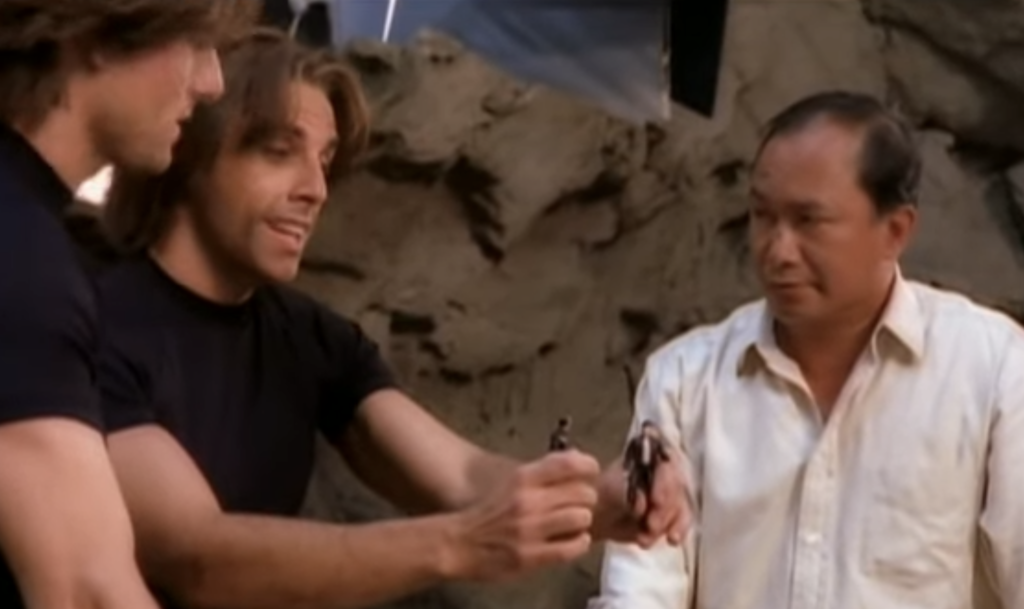
If there’s one thing that’s clear about why people are going to see Barbie, it’s that it’s fun. It’s summer. It’s hot. People are in a good mood. Barbie is like the last piece of the happiness equation. Maybe that’s why nobody wanted to see The Last Voyage of the Demeter. It didn’t scream: “Fun summer movie!”
Then again, neither did Oppenheimer. And I’m pretty sure a lot of people saw that. I’d actually call Oppenheimer “anti-fun.” Man, this box office stuff is hard to figure out. Anyway! The point I was going to make was that Mega Action Hit is the perfect script to read right now. It screams “Fun!”
Dack Benson is the world’s coolest movie star. He’s also a gigantic workaholic. He never stops making films for his Mission Impossible-like franchise, where he plays a member of a super-secret government organization called I.B.S. It’s gotten bad enough that his wife is done with him. She wants a divorce.
Dack has done so many of these freaking movies that he gets careless on one of the wire stunts, falls, and hits his head. When he wakes up, he thinks he’s Dack Benson. Because… HE IS Dack Benson. Character Dack Benson’s name in real life is also Dack Benson. That’s how into making movies this guy is.
But now he thinks he’s his *character,* Dack Benson. And when he sees a news story about a guy named Ivan Shanko (warlord and nudist) procuring a nuke, he recruits his production’s two newest assistants, Julia and Max, to help him save the world. The two think he’s method acting and are so scared to upset the franchise star, they go along with it.
Because Dack does all his own stunts, he’s pretty proficient at a lot of the spy stuff and figures out that something is going down in Turkey. Dack asks the military to fly him to Turkey and because he’s a movie star, they oblige.
Once in Turkey, they learn of the elaborate plan to both secure the nuke, get the uranium, combine the two, and blow up a city! That city, it turns out, is going to be Liverpool. So off Dack, Julia, and Max go. But when they finally catch up to Ivan, Dack gets hit in the head AGAIN, and is now back to being actor, Dack. The problem is he’s so deep in it now, that actor Dack will have to figure out a way to save the world (or Liverpool).
First thing I need to remind you of is that this is one of the last genres you can still legit sell a spec script in. The reason for that is that audiences don’t care about IP when it comes to action comedies. And studios know that if they add action to comedy, it will sell all over the world.
Mega Action Hit asks the question, “What if Mission Impossible made fun of itself?” That’s the concept in a nutshell. I wouldn’t be surprised if Tidwell was hoping Tom Cruise played the part.
Indeed, that would be funny. Actually, I would love to see an in-his-prime Ben Stiller play this role, as he kind of already did back when he pretended to be Tom Cruise’s Mission Impossible stuntman.
But these scripts are trickier than they look. They always sound fun in logline form. But when you have to sit down and flesh them out, you quickly wonder how you’re going to take 20 pages of flesh and stretch it out to 100 pages.
I suppose it doesn’t matter as long as it’s funny.
So is Mega Acton Hit funny?
I did laugh a few times. There’s this scene where Dack, Julia, and Max, are discussing their intricate plan of dismantling a nuclear syndicate while sitting around a computer, then we cut to a wide shot and they’re all sitting in the middle of a Fed Ex store, using one of their rented computers.
There were a lot of fun jabs at how silly the dialogue is in these movies. When the crew is thrust into a dangerous situation, you’d get exchanges like… Dack: “I have a plan!” Julia: “What is it?!” Dack: “I’ll let you know when I think of it!”
Probably my favorite joke was when Dack sees an IBS Treatment Center in the middle of Liverpool and believes it’s an extension of his agency. They, of course, mistake his passion for believing he has *actual* irritable bowel syndrome, and perform emergency surgery on him.
On the flip side, there was comedy I didn’t like. I don’t think that Ivan and his team of nudists were funny at all. Not because it isn’t my type of humor. But because it’s lazy. Just having naked people onscreen for no other reason than “naked is funny” is lazy comedy writing.
Whatever joke you want to include, do it in a clever way. Which is why I liked the IBS joke. It makes fun of the fact that all these industries have the most pointless acronyms. It found a way to work that joke into the story later on (with the IBS Treatment Center). That I can get on board with.
People being nude for no other reason than that naked penises are funny? That’s, quite frankly, lame. Take a lesson from the best comedy scene ever, Ted getting his testicles stuck in his zipper on prom night in There’s Something About Mary. You’ve created an actual scenario around the nakedness as opposed to saying, “These guys are naked. Funny, right???”
Plus, nude doesn’t work on the page because we can’t see them. So even if someone is going to find that funny, they won’t laugh because they can’t see it! And will often forget the characters are nude until you remind them (that’s what kept happening to me while reading this).
A lot more could’ve been done on the character front as well. In comedies, you want your characters rocking those fatal flaws in big bright flashing lights.
Tidwell *does* explore that with Dack wanting to quit to spend more time with his wife. But for some reason I didn’t care. There were no scenes that made me a fanatic Jessica cheerleader. So after the thirtieth time that Dack tells Julia and Max that he wants to quit acting and be with his wife, all I could do was roll my eyes.
It’s hard, I get it. One of the most frustrating things in screenwriting is wondering if something’s working. Is this character working? Is this plotline working? Is this scene working? Is this third act working? Is this CONCEPT working?
But you want to know what I’ve found? I’ve found that, deep down, we know when something’s not working. I know this because I’ve probably given a thousand consultations where, after I sent the notes back to the writer, they said, “Carson, I knew that [that thing] wasn’t working. I just needed you to say it.”
So we know. And the wife thing didn’t work at all here. Which sucks because Tidwell built the entire emotional arc of the movie around it.
Mega Action Hit is fun. But like a lot of these scripts, the fun is too empty. It’s not genuine fun. It’s the kind of fun you have passively watching TV while messing around on your computer. In other words, there’s not enough here for me to endorse it.
[ ] What the hell did I just read?
[x] wasn’t for me
[ ] worth the read
[ ] impressive
[ ] genius
What I learned: A “bridge” scene is not an excuse to be boring. In scripts where your characters are on the move, there’s a temptation that, when they’re on a car ride, or a train ride, or a plane ride, to “offload” some exposition. If you EVER think you can use a scene as a “breather?” As an opportunity to place some important but boring exposition in there, that’s terrible writing. Screenwriting is not about YOU. It’s about the READER. It’s THEIR experience you want to be good. Not yours. Sure, being able to offload that exposition onto a plane scene where we’re waiting for the characters to get to the next destination – that may be helpful to you, the writer. But I can promise you it isn’t going to be fun for the reader. We have that here in a plane scene where Max and Julia share their backstories with each other. BAD! NO! Always always always look to make the scene entertaining. You don’t get any “off” scenes as a screenwriter.

